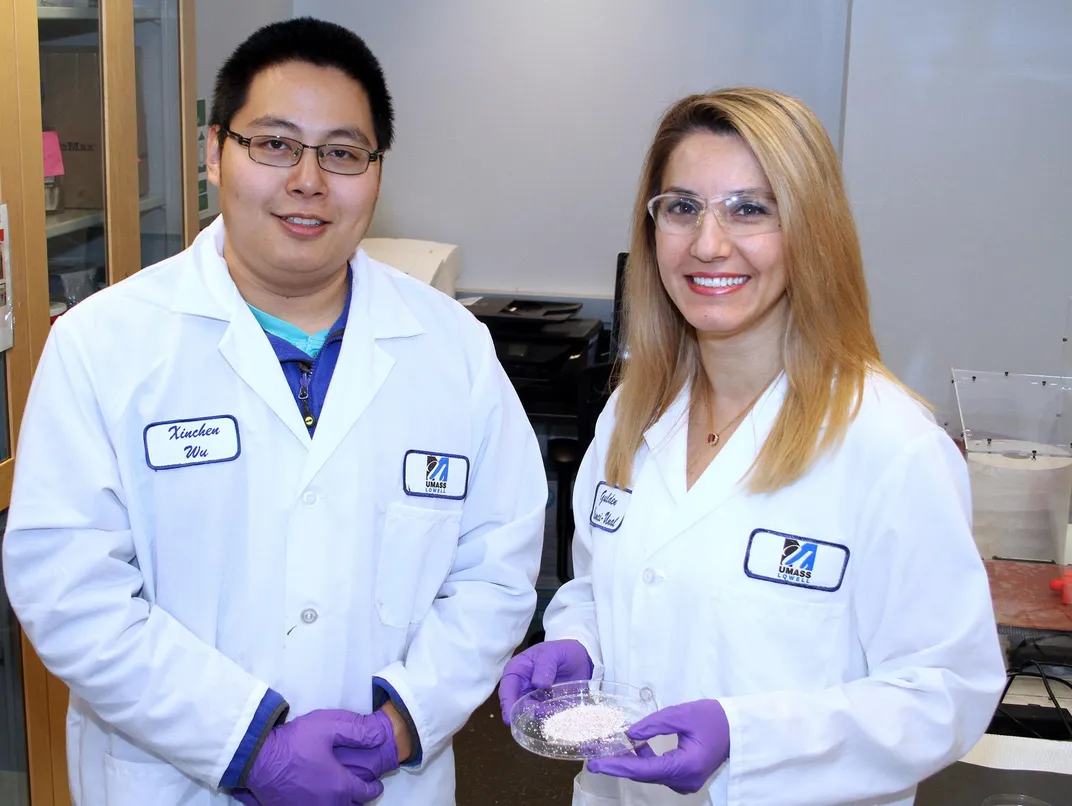How Scientists Are Using Eggshells to Grow New Bone
People with bones damaged by accidents, cancer or aging could one day benefit from bone grafts strengthened with chicken eggshells
/https://tf-cmsv2-smithsonianmag-media.s3.amazonaws.com/filer/50/9f/509f09e3-959c-4ac9-b34a-c1590ca81608/umass_lowell_-camci-unal_research.jpg)
We think of eggshells as fragile. Yet these thin, easily breakable shells may be the key to making better, stronger bone grafts for humans.
Researchers at the University of Massachusetts Lowell (UML) have developed a method of using microscopic particles of pulverized eggshells to help grow new bone. Since eggshells are made mostly from calcium carbonate, a material we already have in our bones, the researchers hope it will be more readily accepted by the body. The material could one day be used to help repair bones impacted by accidents, birth defects or disease.
“There is a great need for developing new and functional materials to repair and regenerate damaged bone,” says Gulden Camci-Unal, a professor of chemical engineering at UML who led the research. “At our lab we like to take unconventional approaches; we look at nature and try to see what we can use that already exists.”
There are millions of bone graft surgeries around the world every year. The bone pieces used for the grafts may come from the patients’ own bodies or from cadavers, as well as from various synthetics. But not all of grafts are successful. Sometimes the grafts fail to induce bone formation, and sometimes they’re rejected by the body.
Camci-Unal’s method, recently described in the journal Biomaterials Science, involves using crushed eggshell particles to reinforce hydrogels—networks of polymers that can hold large amounts of water while maintaining their structure. By themselves, the hydrogels are soft and squishy; the eggshells help strengthen them. The material then serves as 3D scaffolds for osteoblasts, or bone cells.

Using eggshells was appealing in its simplicity, Camci-Unal says. It’s not something synthetic that needs to be engineered in a lab. It’s readily available. It’s also usually wasted.
“We’re trying to take a simpler approach here, which can both benefit the environment and biomedical science,” she says.
Camci-Unal’s team has had success with the material in the lab; it has not yet been tested on animals or humans. The next step will be to survey doctors to understand patients’ needs. The team has applied for a patent for the material and is continuing to study it, by doing further testing at the micro- and nano-scale to better understand how it works.
“We’re trying to understand basically what properties we should be improving better in order for the material to be helpful to humans,” Camci-Unal says.
Brian Amsden, a professor of biomedical engineering at Queens University in Ontario, says he’s seen researchers attempt to make synthetic bone using various materials, but never eggshells. There are synthetic grafts based on on calcium sulfate, on bovine collagen, even on coral, among many others.
“This is particularly innovative in that regard,” he says, adding that eggshell is cheap and readily available, and potentially helps mimic human bone composition better than non-biological materials.
Amsden says there’s a huge need for synthetic bone graft materials. Cadaver bone can be difficult to find, and a patient’s own bone must be harvested in an invasive operation. “You’ve damaged one area now you need to heal two,” he adds. Currently available synthetics tend to be weaker than authentic bone, especially when bending or turning.
Camci-Unal hopes that one day the material could be mixed with a patient’s own cells and applied to a 3D construct to grow into an implant of the correct shape and size. Since the implant would already have the patient’s cells in it, it would be less likely to be rejected. The implants could repair bones damaged by car accidents, combat, aging, cancer or any other number of traumas or birth defects. The material could also potentially be used to grow new tendons, cartilage and teeth.
If successful, the invention would certainly give new meaning to the term “walking on eggshells.”
/https://tf-cmsv2-smithsonianmag-media.s3.amazonaws.com/accounts/headshot/matchar.png)
/https://tf-cmsv2-smithsonianmag-media.s3.amazonaws.com/accounts/headshot/matchar.png)